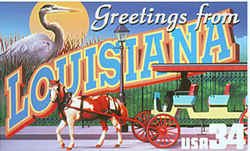
Louisiana Symbols
Louisiana State Mammal
Black Bear

(Ursus americanus)
Adopted in 1992
The black bear, (Ursus americanus,) became Louisiana's official state mammal in 1992.
Louisiana black bears are black, some with a distinct white "blaze" on their chest. Adult males generally weigh from 250 to over 400 pounds and adult females range from 120 to over 275 pounds. Body length of adults, nose to tail, ranges up to 6 feet.
Louisiana State Mammal: Black Bears

Black bears are normally black with a brown muzzle and an occasional white blaze on the chest. Average body weights range from 150 to 350 pounds for adult males and 120 to 250 pounds for females with body lengths from 3 to 6 feet. Black bears are classified as carnivores even thought their omnivorous diet consists mainly of plant material. Black bears are poor predators and only eat vertebrate animals when the opportunity presents itself. Female black bears typically begin having cubs at three to five years of age; however, in marginal habitats, this may increase to seven years. Mating generally occurs in the summer months, and cubs are born in winter dens in January and February. Litter size can range from one to five with twins being most common. The sex ratio at birth usually one male to one female. Cubs measure only 8 inches in length and weigh from 8 to 12 ounces when born.
Characteristics of Louisiana Black Bear
Female black bears begin to mate at 3 to 5 years of age and have one to four cubs every other year. The young remain with their mother the first
year, den with her the following winter, and search for their own territory in their second summer.
Bears tend to range over large areas in search of basic needs such as food, escape cover, den sites, and mates. Males have been known to range over
100 square miles while females occupy much smaller home ranges, often less than 10 square miles.
Although classified as carnivores, Louisiana black bears are not active predators. These intelligent mammals are opportunistic feeders and will eat
almost anything that is available. Although natural foods, such as berries and acorns, comprise a majority of a bear's diet, bears readily take advantage
of food options provided by humans. When available, bears may feed on agricultural crops such as corn, wheat, oats, and sugarcane, occasionally damage
beehives in search of honey, and will readily become habituated to human garbage when the opportunity exists.
Black bears are very intelligent, shy and secretive animals, and generally work hard at avoiding contact with humans. Dangerous situations may occur
whenever close human activity is perceived as a danger to cubs or otherwise threatening. The best advice is for humans to avoid close contact with
bears.
Anatomy
American Black Bears are up to 6 feet (1.8 m) long and weigh up to 300 pounds (135 kg). Their long, thick fur ranges in color from black to brown. Like all bears, they are plantigrade (flat-footed). The front claws are longer than the rear claws. Its habitat in West Virginia is primarily in the eastern mountain region. The black bear still roams freely throughout 36 states and Canada.
Behavior
Black Bears are good swimmers and can also climb trees. They have a good sense of smell but have poor eyesight. They are afraid of Grizzly Bears and stay far away from them.
Cubs
Two to three cubs are born during the winter while the mother hibernates. Cubs stay with the mother for about one year.
Diet
American Black Bears are omnivores who eat plants, leaves, fruits, berries, nuts, roots, honey, insects, and other small mammals.
Reproduction
Females reach sexual maturity at 3 to 4 years of age and mating will take place in June, July and August. Pairs may come together for a few hours or several days, copulating many times. Gestation is approximately 220 days and the cubs are born in their mother's winter den in January or February. Cubs are weaned at around 8 months but may remain with their mother for a year and a half.
Social Organization
Black bears are usually solitary animals except females with young. A pair may come together for several days during mating season and in time of abundant food, several bears may feed closely together with little interaction. Male bears keep large territories that overlap the smaller ranges of several females. Bears will leave territorial signposts both through scent marking and by leaving long claw marks in tree bark.
Louisiana Laws
The law designating the black bear as the official Louisiana state mammal is found in the Louisiana Revised Statutes, Title 49, Section RS 49:161.1.
TITLE 49 - State administration
RS 49:161.1 - State mammal
§161.1. State mammal
There shall be an official state mammal. The official state mammal shall be the black bear. Its use on official documents of the state and with the
insignia of the state is hereby authorized.
Acts 1992, No. 1022, §1.
Taxonomic Hierarchy: Black Bear
Kingdom: Animalia
Phylum: Chordata
Class: Mammalia
Order: Carnivora
Family: Ursidae
Genus: Ursus
Species: U. americanus







